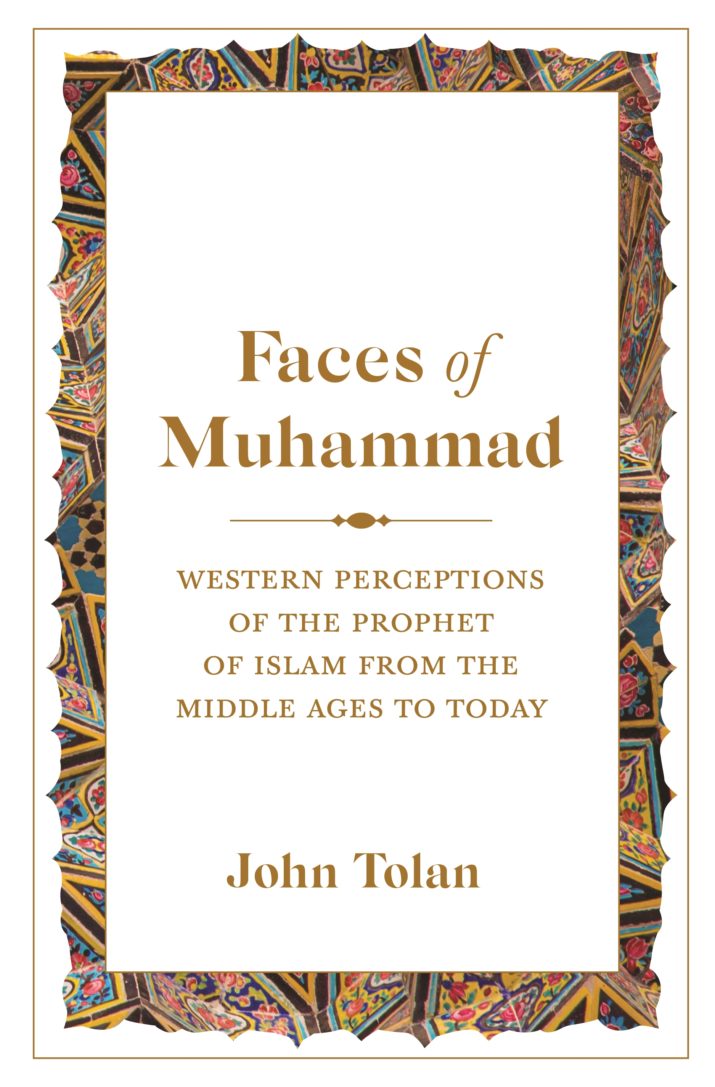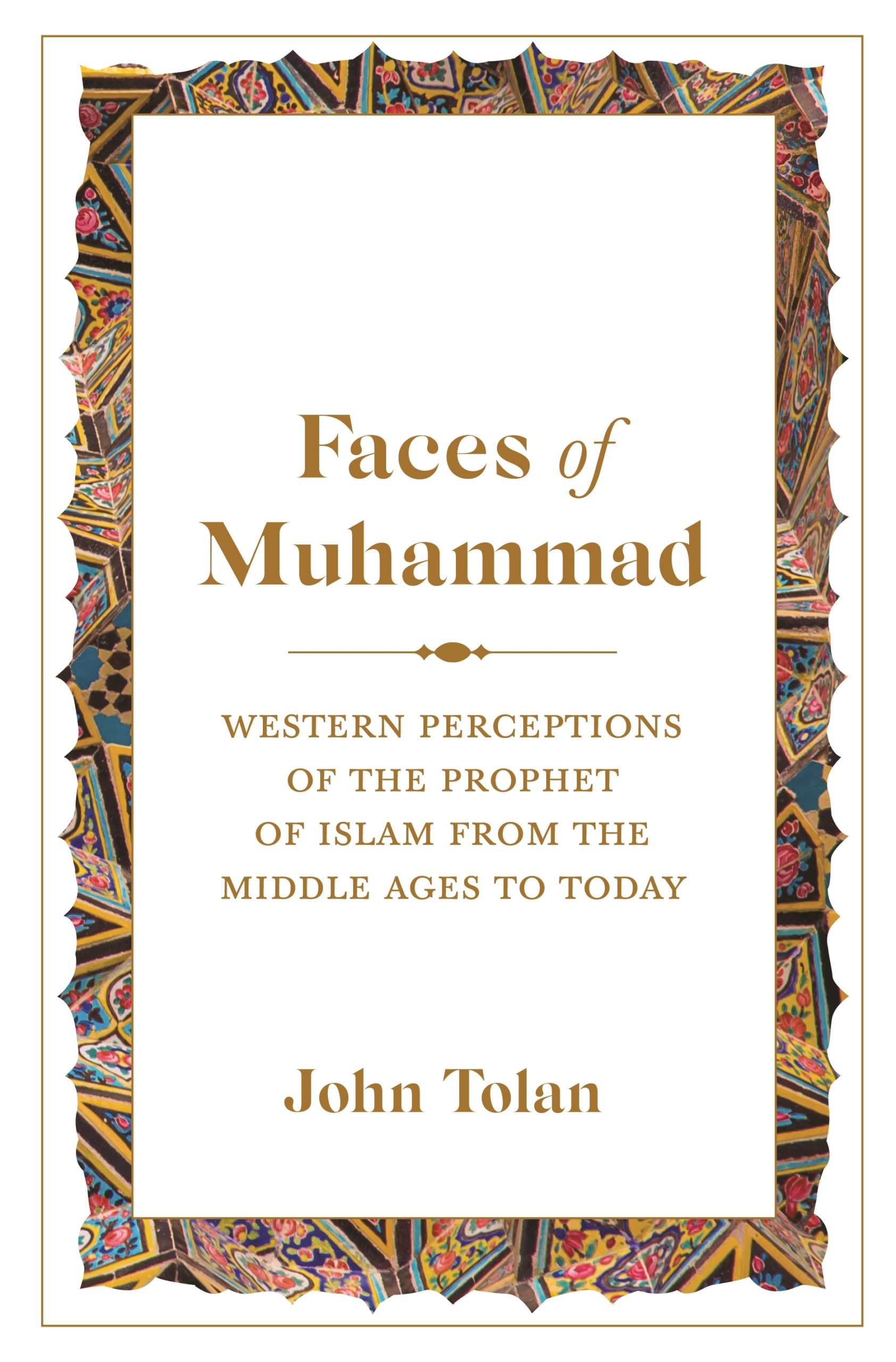
Faces of Muhammad: Western Perceptions of the Prophet of Islam from the Middle Ages to Today by John V. Tolan

John V. Tolan’s Faces of Muhammad contributes to a growing body of scholarship that seeks to understand the myriad ways that literary representations of the Prophet Muhammad are refracted through the concerns and assumptions of Muhammad’s biographers. As Tolan notes, however, much of the scholarship on non-Muslim European representations of Muhammad in the past few decades has focused on polemical and even vitriolic writing. Tolan attributes this focus to postcolonial studies and, more specifically, to the enduring impact of Edward Said’s Orientalism (1978), which led to a critical analysis of the ideological underpinnings of the colonialist project.[1] Faces of Muhammad offers additional complexity to European writing about Muhammad by complicating dichotomizing terms such as “Western” and “Muslim,” and by offering a diverse and nuanced portrait of Europeans’ social, political, and religious concerns between the twelfth and twenty-first centuries. Tolan’s work is unique in that he additionally analyzes visual and even dramatic representations of Muhammad by looking at illuminated manuscripts, stained glass, murals, and liturgical plays. While Faces of Muhammad proceeds chronologically by presenting patterns of literary and visual representations of Muhammad, one may locate three major themes that permeate this work. First and foremost, Tolan highlights the ways in which representations of Muhammad reveal Europeans’ desires and anxieties. Tolan also skillfully depicts the ambivalence non-Muslim Europeans felt about Muhammad, even during a single author’s lifetime. Lastly, representations of Muhammad were the product of an intertextual corpus of material, as demonstrated by the enormous influence that writers and artists had on one another across the centuries. By addressing these various facets, Tolan successfully restores the variety, ambivalence, and complexity of European views of Muhammad and Islam more broadly.
One of Tolan’s initial theoretical moves is to draw attention to what scholars have referred to as the “religious imaginary,” or the way in which religious communities construct their own identities in relation to their perception of other traditions. When referring to non-Muslim European writing on Muhammad, Tolan prefers to reproduce European names given to Muhammad––such as “Mahomet,” “Machomeete,” and “Mahomes”––to indicate the imagined or constructed nature of these representations. This is not to suggest that the “historical Muhammad” can be easily located among Muslim sources, as Tolan also articulates the difficulty in distinguishing between hagiography and history. While Tolan demonstrates that representations of Muhammad were not stable throughout European history, he identifies a number of crucial narrative patterns in non-Muslim writing. Fifteenth-century humanist Laurent de Premierfait’s biography of “Machomet” illustrates a number of these patterns. Like others, Laurent relates that Machomet practiced idol worship, learned parts of the Hebrew Scriptures and the New Testament from Jews and Christians, and engaged in trickery in order to entice followers. One story (vividly illustrated in a number of illuminated manuscripts) depicts Machomet training a dove to eat wheat grains out of his ear in order to deceive people into thinking the Holy Spirit was speaking to him, just as the Spirit had descended upon John the Baptist. Laurent writes that Machomet feigns prophethood and goads his followers to engage in warfare due to a seemingly unquenchable desire for power. Countless other polemical biographies were produced during the thirteenth and sixteenth centuries, some of which became medieval bestsellers, as evidenced by the sheer number of manuscripts.
Tolan argues that these polemical biographies of Muhammad must be understood as providing an outlet for European writers’ (and, indeed, readers’) immediate concerns or anxieties. Accounts that depict Machomet as a heresiarch or charlatan may thus primarily be read as reflecting a widespread preoccupation with heresy among Christians rather than a desire to understand Islam or the Prophet Muhammad. Indeed, many of these writers did not have access to original Islamic sources such as the Qur’an and the hadith (sayings and traditions of Muhammad), and were based on Greek and Latin stories already in circulation. In other cases, European Christians relied on Islamic sources when writing about Muhammad to present a triumphalist image of Christianity, justify the Crusades, or defame proximate Christian heretical movements. Between the twelfth and sixteenth centuries, European writers who did have access to Muslim accounts of the life of Muhammad frequently distorted these narratives. For instance, many European writers accused the Prophet of sinister activity by claiming he had his wife “Cadiga” killed.
In many instances, Europeans’ polemical writing centered not only on Muhammad, but on the Qur’an as well. Riccoldo da Montecroce, for example, used his knowledge of Arabic to compose a thirteenth-century treatise refuting the Qur’an by comparing its “errors” to Christian heretical movements such as Arianism and Nestorianism. Similarly, Tolan argues that writing about Muhammad in seventeenth-century England was heavily influenced by a concern for a number of domestic issues, such as the role of the Anglican Church, the civil war, and the conduct of English kings. In France as well, Comte Henri de Boulainvilliers uses Mahomed as a mouthpiece to articulate his own criticisms of the French Catholic Church by positively describing Mahomed’s condemnation of religious and secular clergy. Though Boulainvilliers’ portrait of Mahomed differs from polemical biographies produced during the thirteenth and sixteenth centuries, his outright rejection of vitriolic Christian accounts similarly conveys a pattern in which writing about Muhammad mirrored European concerns.
Another major theme that emerges in Faces of Muhammad is the significant ambivalence Europeans felt toward Muhammad, occasionally even during a single author’s lifetime. While much of non-Muslim European writing on Muhammad depicts him as a heresiarch, other Europeans saw Muhammad as a great lawgiver, an archetypal prophet, and a religious reformer. Writing in the eighteenth century, Voltaire initially described Mahomet as a religious fanatic. Later in his life, however, Voltaire began to view him as a man who had reshaped and reformed religion. This change of perspective was the result, in part, of Voltaire’s exposure to George Sale’s 1734 translation of the Qur’an. Though he did not write a biography of Muhammad, Ignác Goldziher’s (d. 1921) ambivalence manifested in both a deep admiration for Muhammad’s message as well as a critical view of certain Islamic rituals. Some non-Muslim Europeans were less ambivalent, such as the Scottish Orientalist Montgomery Watt. Watt explicitly rejected the polemical accounts of Muhammad that had been in wide circulation for centuries, criticizing previous writers who maligned the Prophet. Watt portrayed Muhammad as sincere and steadfast in his mission, thus offering a corrective description to previous non-Muslim European accounts.
One of the most compelling consequences of the scope of Faces of Muhammad is the way in which it illuminates the phenomenon of intertextuality, or the relationship among texts through writers’ explicit “borrowing” and embellishment of existing material. Tolan frequently indicates instances in which an author’s exposure to popular European texts about Muhammad or the Qur’an results in his own composition of a work. Thus, Laurent’s biography of Machomet was partly inspired by Vincent de Beauvais’ account of the Prophet, which, in turn, influenced the composition of a number of other texts. Intertextuality and influence is also demonstrated vividly in Jewish writing about Muhammad during the nineteenth century. Many Jewish intellectuals during this time were centrally concerned with the role Judaism should play in European society. Formative leaders of the Wissenschaft des Judentums movement (“the Science of Judaism”) wrote extensively on the topics of assimilation, emancipation, and religious reform. Abraham Geiger, Gustav Weil, and Heinrich Graetz were interlocutors who, through reading each other’s work about Muhammad and the Qur’an, constructed their own insights about how Judaism should be practiced. As with earlier European material, Jewish writing about Muhammad provided a means through which intellectuals could address pressing societal concerns. For Geiger, Mohammed preached a religion that was stripped of needless rituals, though he ultimately concluded that Islam was a derivative form of Judaism. His reading of Mohammed was thus informed by his own preoccupations with Jewish integration. Studying alongside Geiger, Weil shared concerns for a renewal of Judaism, but he disagreed with Geiger’s perception that Islam was an inferior form of Judaism.
The phenomenon of influence is also apparent in the transmission of visual representations of Muhammad. The narrative of Machomeete preaching with doves at his ears was reproduced in a number of paintings, and many other illustrations that depicted Machomeete’s undignified death were in circulation as well. Indeed, Tolan’s combined analysis of literary and visual representations adds particular nuance to studies of Muhammad, which have primarily focused on narrative. Tarif Khalidi’s Images of Muhammad (2009), for instance, analyzes patterns of influence among biographies of Muhammad based upon shared geographic and temporal space.[2] Similarly, Kecia Ali’s work, The Lives of Muhammad(2014), centers on Muslim and non-Muslim writers’ shared literary conventions and argument styles from the late nineteenth century to the present.[3] Tolan’s careful analysis of visual representations produces a picture of audience reception and agency that more fully reflects audiences’ multisensory engagement with material objects. This is shown in a thirteenth-century illuminated manuscript of the Chanson d’Antioche, which depicts a Saracen general, Sansadoines, destroying the idol of Mahomet. In the image, some of the paint is scratched off––perhaps deliberately by readers––as an expression of disdain toward idol worship. While Faces of Muhammad predominately focuses on writers’ and artists’ preoccupations, such examples illustrate that audiences were similarly invested in constructing their identities in relation to the imagined Muhammad.
Faces of Muhammad is a magisterial work that offers a complex portrait of European identity. Covering a vast number of sources across ten centuries, Tolan manages to deeply contextualize each text and painting, resulting in a clearly articulated web of influence and intertextuality. The sheer scope of this work and the care with which Tolan treats his sources will surely engage scholars drawing from a wide range of interests. The joint focus on literary and visual representations of Muhammad may additionally provoke a more nuanced discussion among specialists in regard to the embeddedness of visual and literary culture.
Stephanie Yep is an Assistant Professor of Religious Studies at Appalachian State University. Her research explores the ways in which pre-modern biographers of Muhammad sought to articulate boundaries of emotional comportment to their audiences.
Faces of Muhammad: Western Perceptions of the Prophet of Islam from the Middle Ages to Today
By John V. Tolan
Publisher: Princeton University Press
Hardcover / 309 pages / 2019
ISBN: 9780691167060
[1] Edward W. Said, Orientalism (New York: Pantheon Books, 1978).
[2] Tarif Khalidi, Images of Muhammad: Narratives of the Prophet in Islam across the Centuries (New York: Doubleday, 2009).
[3] Kecia Ali, The Lives of Muhammad (Cambridge: Harvard University Press, 2014).
Published on March 10, 2020.




